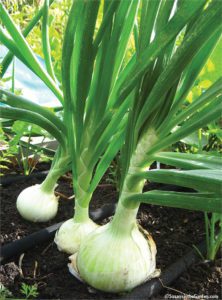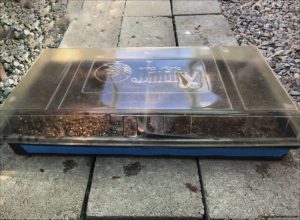A new twist on planting onions

I just learned something intriguing about planting onions and wanted to share it with you.
As you know, you can grow onions from seeds, sets (little bulbs) and from plant starts. For years, I used onion sets but had mediocre results with them. The bulb size was small and their overall plant vigor was lacking.
Several years ago, I was turned on to growing onion plant starts which worked out great. It opened up a whole new world to me. Plant the correct TYPE of onion, based on the day-length in one’s region.
I live in the Inland Northwest (specifically Spokane, Wash.) where we have very long days during the summer. The best type of onion to grow here is a long-day variety. Once I knew that, and used plant starts, I had much better success. I still ran into problems. They had to do with interruption in the plants’ growth between when they were harvested in the field where I bought them and when I could plant them in my garden. And that makes a big deal.
The same applies to onion sets. Think about how a grower plants onion seeds and lets the bulbs grow to a certain size. Then they harvest them for a gardener to plant much later. It makes sense that the vigor of your plants is going to be compromised.
OK, now that you’ve digested all of this, let me freak you out a bit!
The blog post that made a difference!
A Master Gardener colleague of mine recently pointed me to a gardening blog. The blog, SavvyGardening.com, has a recent post written by a writing colleague of mine, Jessica Walliser. I know Jessica from attending writers’ conferences and from her excellent book, Attracting Beneficial Bugs to Your Garden.
The post was Why planting onion seeds is better than planting sets (and how to do it right). Jessica further explained what I’ve discussed above. What really caught my attention was her suggestion of the easiest way to plant onion seeds. And that was without using plant lights or heating mats. That way, the onion seedlings wouldn’t have interrupted growth.
Jessica proposed that we plant our onion seeds in a flat and water them in. Then cover the flat with a plastic lid and then place the flat OUTSIDE! Like, right now.
Planting onions a whole new way
I had to read this a couple of times to make sure I was seeing right. She says that as soon as the conditions are appropriate, the seeds will germinate and grow. They’ll already be acclimated to our weather conditions. And what’s more, they can be planted in our gardens as soon as it’s safe to work the soil.
Jessica says it doesn’t matter how cold or snowy it is when we place our flats outdoors. This seems hard to believe but, being the intrepid gardener that I am, I’m going for it! I wimped out one thing, though. I placed the flat on the floor of my small, unheated greenhouse, rather than our deck. At the rate we’ve been getting snow this winter, I didn’t want it to get crushed and buried. So there’s the flat in the photo to the left.
In case you’re curious, the two varieties I planted are ‘Ringmaster’ and ‘Yellow Sweet Spanish Utah’. Both are long-day varieties, which are perfect for Northern climates. Are you unfamiliar with onion types based on day length? Here’s a good explanation of it on Dixondale Farm’s website, along with varieties of each type.
Be sure to read Jessica’s post (see above link). And I’ve love to hear if you’re going to do it and what your results are. Drop me a note at Susan@susansinthegarden.com.


